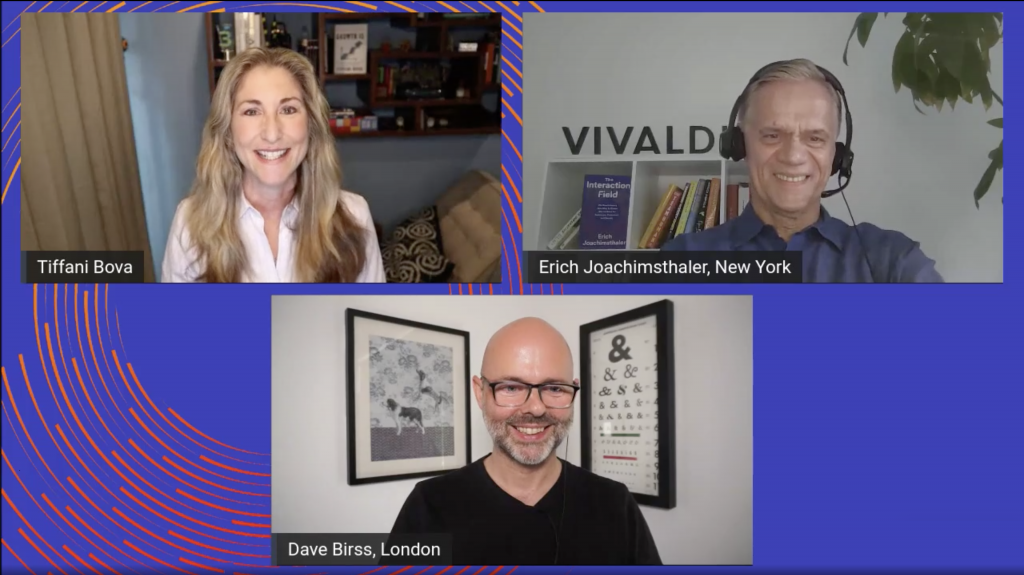Growing your company during the pandemic seems impossible, but you may come out a champion if you know the steps to get there. In this invigorating discussion with Tiffani Bova, author of “Growth IQ” and Global Customer Growth and Innovation Evangelist at Salesforce, and Erich Joachimstahler, Founder and CEO of Vivaldi, discussed the key elements of what helps the best companies grow today. Tiffani and Erich chat about how companies can take advantage of internal and external levers to position themselves for explosive growth. Tiffani taught us the importance of focusing on getting the job done, working with competitors, and the positive business outcomes of social responsibility.
Some key Growth principles from Tiffany Bova:
1. The way to hack growth is to shift the mindset from focusing on the product alone to getting the job done. Growth is a thinking game. It is thinking about the competition, the engagement that can be formed from the product, and decoupling services to respond to what customers need today. Shifting the company mindset from pushing the product to solving for the problem across the landscape allows companies to disrupt the industry and create distinctive value.
Tiffani shared how Apple has made a disruption by thinking about customers’ pain points who use mp3 players such as their own iPod. By combining the two things people always carry which are the iPod and their phone, they created an innovative solution. It has become a standard for every phone in the market today. Still, they remain dominant because of the created value and culture they orchestrated along with the outstanding product.
“If you look at anyone who has really disrupted, it’s the one that has looked out across the landscape. They had the ability to think about what was someone going to need five or ten years from now.” – Tiffani Bova
2. Working with competitors or Co-opetition can solve systemic problems within the ecosystem. Co-opetition is cooperating with the perceived competitor through a partnership or a combined service. Looking at where companies overlap and don’t overlap in their products and services can help solve their shared audience’s problems while serving implicit problems within their landscape.
Tiffani gave us an example of how co-opetition played out within the airline industry. Recently, the one thing that travelers might not encounter as much as they did before is the inconvenience of transferring from a connecting flight by going through the second round of check-ins and luggage claims. It was solved by competing airlines cooperating and making the process more seamless for their travelers.
“For me, as a customer, as a passenger, it’s much better if the airlines work together because it makes a better experience for me. While they may overlap in very small markets, the bigger part of the pie that they don’t— that gives me a better experience.” – Tiffani Bova
3. “Doing well by doing good— if you can, then you should!” Borrowing the principles of nonprofit organizations, using the mindset of giving back to society could open new opportunities and unexpected partnerships. By starting with the customer, there is a prospect to create a platform of change.
Salesforce’s partnership with CVS is a great example. During the pandemic’s height, the CEO of CVS committed to provide and donate personal protective equipment to those in need. Through this response, Salesforce secured a partnership with CVS to help workers get back to the office safely.
“It isn’t just that we drive the profits— we drive the growth, and we compete in a marketplace. Here is a strategy to make more money, and if we feel good, we donate or have some social purpose to the business. I think that’s important in this day and age—we are all connected.” – Erich Joachimsthaler
Intelligent Growth Tips:
- Fostering company culture translates to customer experience: Companies must take care of both their employees and customers. The result of how the company cultivates its employees’ culture ultimately translates to how customers perceive the service or product offered by the company.
- Beat competitors through capitalizing uniqueness and make it memorable: Capturing a particular way your company could serve the customers should be capitalized. It’s not about being unique in product variation. It’s about keeping collaboration and communication with customers open and fluid.
- Identify the conflict of interest to overcome stagnant growth: Whether the conflict of interest is about regulatory, brand, or control conflicts, determining and deconstructing the dominant obstruction will clear growth roadblocks.
Conclusion
In Growth IQ, Tiffani, a self-identified Growth Anthropologist, wrote 30 short stories and case stories about businesses who have succeeded and learned from decisions that affected their business growth model. Today’s companies can learn from each other and benefit from blurring the traditional lines across organizations, customers, and competitors. The idea of companies understanding their ecosystem players and mindfully increasing connectivity to solve big problems for consumers is based on the interaction field business model. Companies that deconstruct obstacles may help brands create opportunities for unlikely co-opetition or partnerships.
Watch the full event here:
- 7:55 – Taking a hard look at people & process for the right kind of growth
- 11:40 – Solution to stagnant growth
- 13:57 – Thinking shift from product to the job needs to be done
- 14:32 – Growth is a thinking game– think iPods
- 15:30 – Importance of fostering an innovation culture
- 16:09 – Employee happiness translates to customer experience
- 17:00 – You need a company that has no organizational boundaries
- 17:42 – Role of silos and the importance of connection
- 19:00 – Tiffani explains how to blur boundary lines bet customers and employees
- 19:55 – Understand what makes your company unique and capitalize it
- 24:40 – Use the not for profit model to give back
- 28:15 – Explanation of Co-opetition and airline example
- 31:32 – Amazon as a co-opetition example
- 32:51 – Importance of looking into the supply chain especially during the pandemic
- 33:40 – Salesforce’s unexpected partnership with CVS led to new opportunities
- 37:10 – Proprietary planning and alignment with consumers (where she holds up the USB cord)
- 39:36 – Policy and regulation changes can be changed through partnerships
- 41:33 – Value creation is made through collaboration, participation, and connection— not through competition
- 42:01 – Decoupling a stack of services
- 43:55 – Investigate company workflows
This segment was part of The Interaction Field Series of our LinkedIn Live Events. Please connect with us on our LinkedIn page to stay updated with our upcoming conversations.

